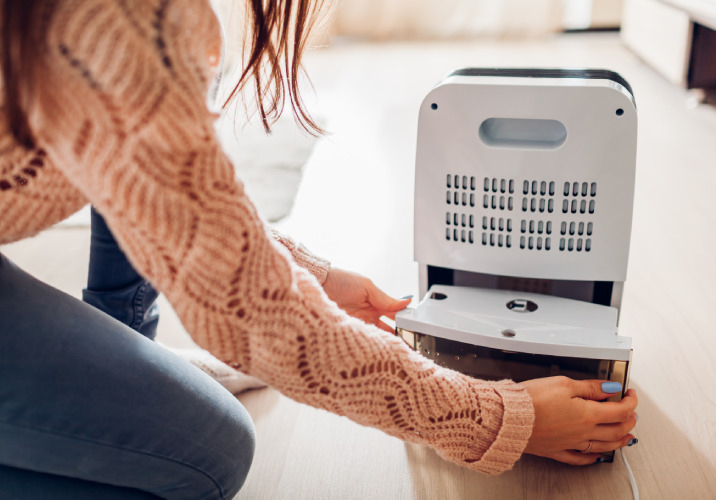
Find a local air conditioning and heating expert
- Inspiration /
- Indoor projects /
- Heating & cooling /
- What does a...
What does a dehumidifier do?
Why you should have one in your home
You absolutely need to be comfortable within your own home, and one way to ensure extreme discomfort is to have a home that is too humid. It feels lousy, and you’re also opening up your abode to some very harmful things. Humidity creates a moisture-laden home that could bring about a horribly unhealthy environment. It could lead to plenty of mould and other harmful allergens throughout the whole house. So, how do you combat this humidity? The easiest way is to invest in a good, strong dehumidifier. A good dehumidifier will take out all of the excess moisture in the air, making the whole home more comfortable and safer for anyone living there.
The benefits of a dehumidifier
They get rid of mould and musty odours
An excessively humid home can promote the growth of mildew and mould, which will end up emitting an unsavoury musty smell. Mould and mildew thrive in wet environments, and the smell is not easy to eradicate if you do not tackle the source of the dampness. A dehumidifier is beneficial in the sense that it removes the excess moisture from the air, which stops the growth of mould and mildew and eliminates the nasty musty smell. Mould and mildew can also be detrimental to your respiratory health, so using a dehumidifier can help prevent illness.
They promote the longevity of your home contents
Dehumidifiers help protect your home’s contents from the effects of excessive moisture. They also promote the longevity of items, such as clothing, books, food and shoes. These items will also never smell musty as a result. A dehumidifier will also prevent household pests, such as silverfish, from thriving, which helps protect your books and clothing.

They help enhance your health
A humid environment is not very conducive for those who are prone to airborne allergies and asthma. A dehumidifier would therefore come in very handy, as they promote temperature stability. Dehumidifiers also have the added benefit of including a filter that assists in eradicating air pollutants, such as dust, mould spores and pollen. This promotes a healthier indoor environment for you. Dust mites are also reduced within the home since they can only thrive in humid environments. This can help reduce allergic reactions and asthma attacks.
They are beneficial for drying clothes
Dehumidifiers are ideal when it rains and you are unable to hang your clothes outside to dry or if you prefer not to use a dryer. All you need to do to dry your clothes in record speed is secure them on a drying rack in close proximity to the dehumidifier. Another added advantage is that your wet clothes would not be adding to your home’s humidity. Dehumidifiers are also able to dry clothes overnight, and they are also more energy-efficient than dryers since they use less power. This means you’ll have lower electricity bills, which also makes dehumidifiers a cost-effective choice.
Types of portable dehumidifiers
Absorbent
For small areas that require the removal of moisture, an absorbent dehumidifier is an ideal option. For instance, the Hippos you observe in department stores, hardware stores and supermarkets are containers that hold absorbent material like silica gel. This material absorbs the moisture in the air and pushes the water down to a collection area. Once it is full, you simply dispose of the excess water. This is ideal in cupboards and closets. For smaller areas, utilise sachets or silica gel, which will help mitigate mould.
Refrigerant
By drawing warm, moist air from the room, a refrigerant dehumidifier runs the air through several coils that have been cooled and returns dry air to the environment. This process is extremely effective because the warm air meets the cold coils, resulting in condensation. This water then drips into a bucket, which must be periodically emptied. Another option is for the excess water to drain through a special tube. These dehumidifiers are available in a variety of sizes to fit any room and can be easily moved. Additionally, for extra-moist areas, several can be run simultaneously.
Desiccant
Similar to refrigerant dehumidifiers, this equipment sucks warm, moist air and also expels dry air. The difference is that as opposed to removing the moisture-utilizing cold coils, there is a bed of desiccants inside, which absorb the moisture. The excess water is then drained into a bucket, which must be emptied. Similarly, the other option is a special tube that drains directly outside. Additionally, these are available in a variety of sizes and can easily be moved and paired with other dehumidifiers.

Finding the right dehumidifier for your house
The first thing you should do is examine the layout of your house so you can pick out just the right type of dehumidifier. Examine the space where you’re going to put in the dehumidifier. Take into account how big or how small the space is, how much average humidity is in the space, and how much you use the room. If you have a smaller room you’d like to make more comfortable, there’s no need to pick up a gigantic dehumidifier – and vice versa. Check-in on the specifications on every dehumidifier. Look at the capacity first. Your average dehumidifier for a one- or two-bedroom home should be able to take out 10 litres of water from the air every day, while ones designed for bigger houses need at least double that capacity. Next, look at how much noise the dehumidifier will produce. If you have it in an area where you’re constantly working, louder dehumidifiers might quickly become annoying.
You also want to look for a home dehumidifier that is easily transportable. Try to avoid the super-heavy ones, and look for dehumidifiers that can be moved from one room to another. You should also definitely invest in a dehumidifier that has a device called a ”humidistat” This device automatically adjusts the levels, so you’re not constantly turning the dehumidifier up and down.
Climate considerations
Where you live also plays a part in choosing the right type of dehumidifier. The wetter the area you live in, the more powerful your dehumidifier should be, as there’s that much more moisture that needs to be removed from the air. If your climate is a more temperate one, you might want to get a smaller, more portable dehumidifier that can easily be moved from one room to another. That’s all you should need. If you have any questions about the capacity of the dehumidifier, ask a local expert at a home-supply store. They should be able to give you all the information you need.
How much will your job cost?
The Oneflare Cost Guide Centre is your one-stop shop to help you set your budget; from smaller tasks to larger projects.



